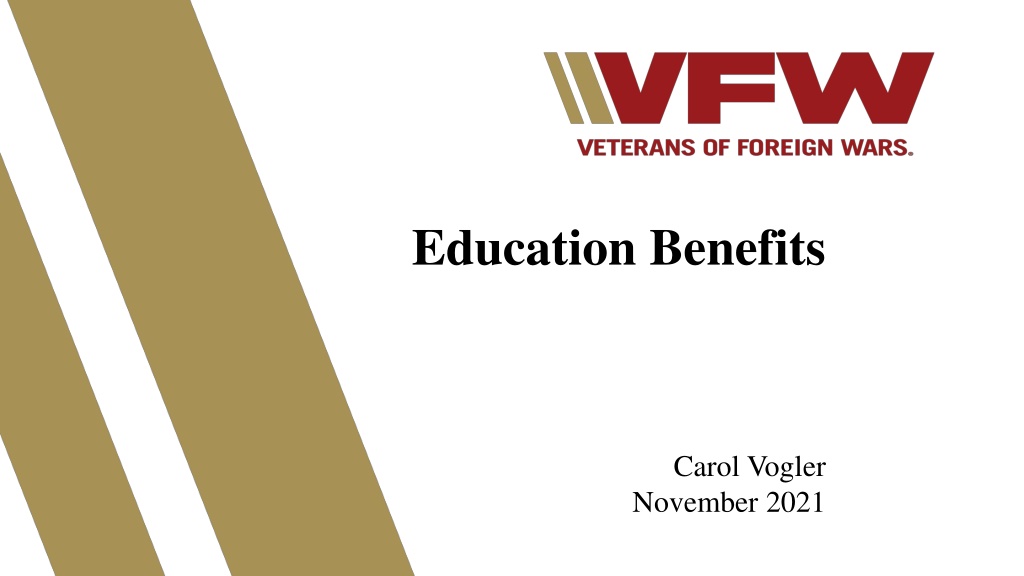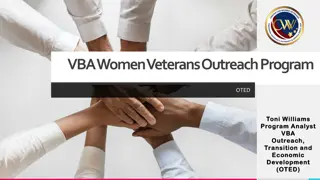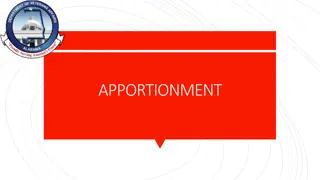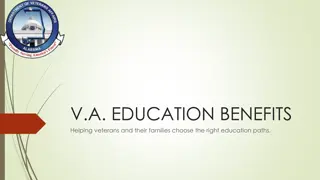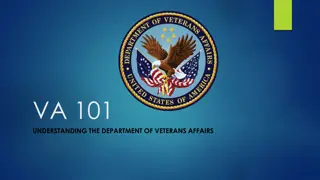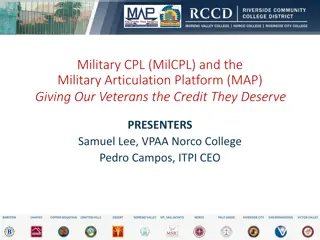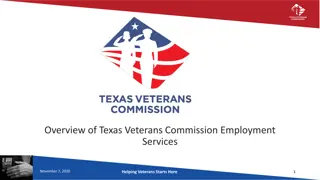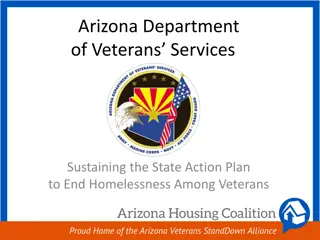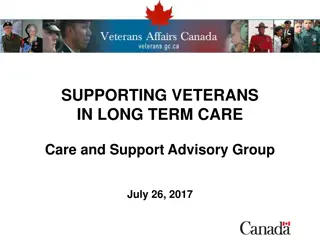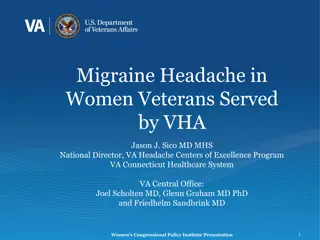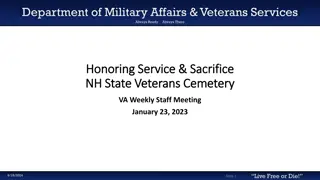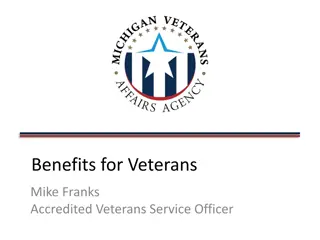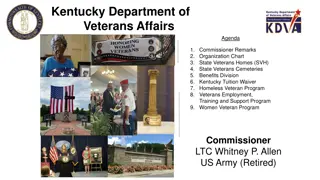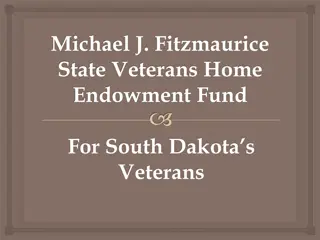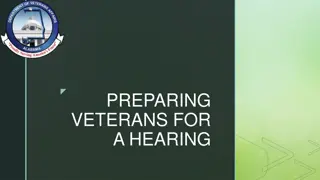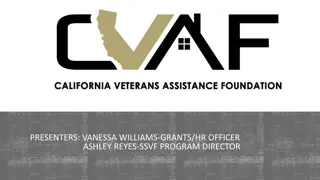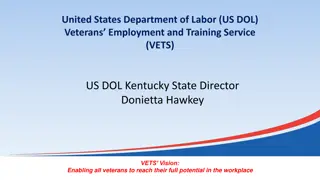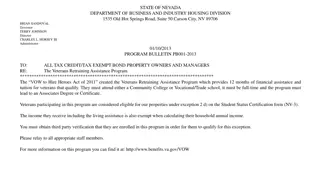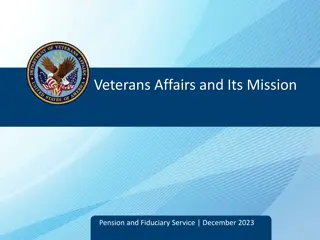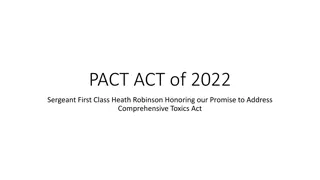Understanding VA Education Benefits for Veterans: A Historical Overview
Explore the rich history of VA education benefits, from the Servicemen's Readjustment Act of 1944 to the Post-9/11 GI Bill. Learn about key programs like the Montgomery GI Bill, Yellow Ribbon Program, and more that support veterans in pursuing education and career opportunities.
Download Presentation

Please find below an Image/Link to download the presentation.
The content on the website is provided AS IS for your information and personal use only. It may not be sold, licensed, or shared on other websites without obtaining consent from the author. Download presentation by click this link. If you encounter any issues during the download, it is possible that the publisher has removed the file from their server.
E N D
Presentation Transcript
Education Benefits Carol Vogler November 2021
Introduction Carol D. Vogler caroldvogler@gmail.com 501-690-4627 Department of Veterans Affairs Little Rock, Arkansas SSVSR 2
Objectives History of VA Education Montgomery GI Bill Post 9/11 GI Bill Yellow Ribbon Program Forever GI Bill Transfer of Entitlement Post 9/11 GI Bill Edith Nourse Rogers STEM Scholarship (STEM) Veteran Employment Through Technology Education Course (VET TEC) 3
Objectives continued Veteran Rapid Retraining Assistance Program (VRRAP) Veterans Readiness & Employment (VR&E) (Chapter 31) Chapter 36 Education & career counseling Education benefits for dependents and survivors (Chapter 35) Marine Gunnery Sergeant John David Fry Scholarship 4
History of VA Education Benefits Servicemen s Readjustment Act of 1944 was signed into law by President Franklin Roosevelt on June 22, 1944 Final cut off date July 25, 1956 Veterans Readjustment Assistance Act of 1952 Korean Conflict GI Bill Final cut off date January 31, 1965 Veterans Education and Employment Assistance Act of 1976 (VEAP) Post-Vietnam Era Veterans Educational Assistance Final cut off date June 30, 1985 5
History continued Veterans Readjustment Benefits Act of 1966 Post-Korean Conflict and Vietnam Era GI Bill Final cut off date December 31, 1989 Department of Defense Authorization Act 1985 Montgomery GI Bill Must have entered active-duty on or after June 30, 1985 Chapter 30 Active Duty Chapter 1606 Selected Reserves REAP Program Also know as the National Call to Service Program Post 9/11 Veterans Education Assistance Act of 2008 Forever GI Bill Harry W. Colmery Veterans Educational Assistance Act 6
Post 9/11 GI Bill Eligibility Serve at least 90 days active duty after September 11, 2001 Honorable discharge (some exceptions apply) To qualify for full-benefits service member or Veteran must have served at least three years of active duty after September 10, 2001 Serve at least 30 continuous days on active duty and must have been discharged due to a service-connected disability The following chart reflects the eligibility criteria prior the the Forever GI Bill effective August 1, 2020 8
Eligibility Member Serves Percentage of Maximum Benefit Payable At least 36 months 100% At least 30 continuous days on active duty and must be discharged due to a service-connected disability 100% At least 30 months, but less than 36 months 90% At least 24 months, but less than 30 months **At least 18 months, but less than 24 months 80% 70% **At least 12 months, but less than 18 months 60% **At least 6 months, but less than 12 months **At least 90 days, but less than 6 months*** 50% 40% **Excludes time in basic training and/or skill training Rate chart effective prior to Forever GI Bill 9
Benefit entitlement Tuition and Fee Payment (paid directly to school) Full cost of public, in-state tuition and fees Rates are capped for private and foreign schools; these rates are updated each year. Current rate, up to $26,042.81 per academic year National Maximum Monthly housing allowance - if enrolled more than half-time (paid to Veteran) Books and supplies stipend up to $1,000 per school year (paid to Veteran) If attending IHL as a non-resident student or a private IHL that is more expensive than the annual cap, may be eligible for extra payment thru the Yellow Ribbon Program 10
Yellow Ribbon Program The Yellow Ribbon Program can help pay for higher out-of-state, private school, or graduate school tuition that the Post-9/11 GI Bill doesn t cover. School must meet all the following requirements: Is an institution of higher learning, and Offers the Yellow Ribbon Program, and Hasn t offered the Yellow Ribbon benefit to more than the maximum number of students in their agreement with VA, and Has certified student's enrollment and provided Yellow Ribbon Program information 11
Yellow Ribbon Eligibility Student must qualify for the maximum benefit rate under the Post-9/11 GI Bill. To qualify, at least one of these must be true: Served at least 36 months on active duty (either all at once or with breaks in service), or Received a Purple Heart on or after September 11, 2001, and were honorably discharged after any amount of service, or Served for at least 30 continuous days (all at once, without a break) on or after September 11, 2001, and were discharged after 60 days with a service-connected disability, or Are a dependent child using benefits transferred by a Veteran or a service member who has served for at least 36 months on active duty and qualifies at the 100% level, or Are a Fry Scholar (eligible for the Yellow Ribbon Program on or after August 1, 2018) Note: As of August 1, 2022, active-duty service members who qualifies at the 100% level, or the spouse using the transferred benefits of an active-duty service member who qualifies at the 100% level may be entitled to Yellow Ribbon Program 12
Forever GI Bill Excellent reference tool to the Forever GI Bill Harry W. Colmery Veterans Educational Assistance Act which has links to the updated benefits https://benefits.va.gov/GIBILL/FGIBSummaries.asp www.gibill.va.gov 14
Forever GI Bill Reservist ordered to active duty to receive medical care on of after September 11, 2001, now counts as active duty toward eligibility for Post-9/11 GI Bill beginning on or after August 1, 2018 Service members and honorably discharged Veterans who were awarded a Purple Heart on or after September 11, 2001, are now entitled to benefits at the 100-percent rate for up to 36 months of entitlement effective August 1, 2018 Recipients of the Fry Scholarship and Purple Heart will be covered under the Yellow Ribbon Program effective August 1, 2018 Yellow Ribbon Program may be used by active-duty service members effective August 1, 2022 15
Forever GI Bill - Eligibility Member Serves Benefits effective 8/1/2020 (elimination of 40%) Percentage of Maximum Benefit Payable At least 36 months or received a Purple Heart on or after 9/11/01 (Purple Heart effective 8/1/18) At least 30 continuous days on active duty and must be discharged due to a service-connected disability 100% 100% At least 30 months, but less than 36 months 90% At least 24 months, but less than 30 months 80% At least 18 months, but less than 24 months 70% At least 6 months, but less than 18 months 60% At least 90 days, but less than 6 months 50% 16
Forever GI Bill REAP Eligibility credited toward Post 9/11 GI Bill Program Monthly Housing Allowance (MHA) is to be calculated based on the zip code of the campus where the student physically attends most of their classes, rather than the location of the IHL where the student is enrolled. This applies to the first enrollment in an education program on or after 8/1/18. Changes to Licensing and Certification Charges Assistance for students affected by school closures and certain disapprovals 17
Forever GI Bill continued Assistance for Post 9/11 GI Bill students impacted by the Colmery Act MHA changes Changes to Transfer of Entitlement STEM Benefits Elimination of 15-year limitation to use the Post 9/11 GI Bill Program Removes the time limit for use of Post-9/11 GI Bill for individuals last discharged or released from active duty on or after January 1, 2013, children of deceased service members who first became entitled to Post-9/11 benefits on or after January 1, 2013, and all Fry spouses. All others remain subject to the current 15-year time limit to use benefits 18
Forever GI Bill continued Reserve Components Monthly Housing Allowance VA will prorate the MHA stipend for members of the reserve components Established a five-year pilot program for Veterans to training in the high-tech industry (VET TEC) Work study Expansion removes expiration date of June 30, 2022, for certain qualifying work-study activities Changes to Survivors and Dependents Educational Assistance (DEA) 19
Forever GI Bill continued Using GI Bill at Technical Schools and non-Institutions of Higher Learning (IHLs) effective August 16, 2017 Priority Enrollment effective August 16, 2017 Informing School about Beneficiary Entitlement effective August 1, 2018 Reserve Component Benefits GI Bill Monthly Housing Allowance individuals who first used Post 9/11 GI Bill on or after January 1, 2018, will receive monthly housing allowance based on DoD s reduced basic housing allowance (BAH) for monthly housing rates. Those that began using benefits prior to January 1, 2018, will continue to receive a higher monthly housing rated based on the non-adjusted BAH rates. 20
Transferability Post 9/11 GI Bill Service members may be eligible to transfer education benefits while they are on active duty or in the Selected Reserve and meet all the requirements listed below. All of these must be true: Must have completed at least 6 years of service on the date request is approved, and Must agree to add 4 more years of service, and The person getting benefits is enrolled in the Defense Enrollment Eligibility Reporting System (DEERS). 21
Transfer of Entitlement Children still qualify even if a child marries Spouse may still be qualified even if they are divorced from Veteran However, service members and Veterans can revoke (cancel) or change a TOE at any time. If entitlement is totally revoked transferred benefits for a dependent and service member is still in the service, they need to complete another transfer request for the dependent through milConnect. If a dependent s transfer eligibility has been totally revoked, benefits cannot be transferred again to that dependent. 22
Transfer of Entitlement - Spouse May use the benefit right away May use the benefit while service member is on active duty or after they have separated from service Don t qualify for the monthly housing allowance while service member is on active duty May use the benefit for up to 15 years after Veteran has separated from active duty 23
Transfer of Entitlement - Children May start to use the benefit only after service member finished at least 10 years of service May use the benefit while service member is on active duty or after they separated from service May not use the benefit until they ve gotten a high school diploma (or equivalency certificate), or have reached 18 years of age Qualify for the monthly housing allowance even if service member is on active duty Can t use the benefit after they ve turned 26 years old. 24
Transfer of Entitlement Forever GI Bill updates Veterans who transferred entitlement to a dependent can now designate a new dependent if the original dependent dies before using the entitlement. Dependents who received transfer of entitlement can transfer their entitlement to another eligible dependent if the service member or Veteran who made the transfer subsequently dies. This law applies to death on or after August 1, 2009, and took effect August 1, 2018 25
STEM Edith Nourse Rogers Science Technology Engineering and Math (Rogers STEM) Scholarship The Rogers STEM Scholarship provides up to nine months of additional Post 9/11 GI Bill benefits (with a maximum of $30,000) to qualifying Veterans and Fry Scholars seeking an undergraduate STEM (Science, Technology, Engineering and Math) degree or who have earned a STEM degree and are now seeking a teaching certificate. Priority is given to students who are entitled to 100% of the Post 9/11 GI Bill benefits and those who require the most credit hours. The STEM Designated Degree Program List can be viewed at va.gov 26
VET TEC Veteran Employment Through Technology Education Courses (VET TEC) A five-year pilot program for eligible Veterans to help them secure meaningful employment in the technology sector. The program pairs eligible Veterans with market-leading training providers that offer training and skills development in areas such as information science, computer programing, data processing, media applications and computer software programs. 27
VET TEC continued Veterans with at least one day of unexpired GI Bill entitlement may be eligible. Participants receive tuition for a full-time high-tech training program and money for housing during training. VET TEC is subject to law to a $15 million annual budget. If the annual budget cap is hit, VA will not accept new VET TEC student enrollment until additional funding is secured or the new fiscal year starts on October 1. 28
VRRAP Veterans Rapid Retraining Assistance Program (VRRAP) Offers education and training for high-demand jobs to Veterans who are unemployed because of the COVID-19 pandemic. Eligibility: At least 22 years old, but not older than 66, and Unemployed because of the COVID-19 pandemic, and Not rated as totally disabled because you can t work, and Not enrolled in a federal or state jobs program Cannot receive VRRAP benefits at the same time as receiving unemployment benefits (including CARES Act benefits). 29
VRRAP continued Cannot be eligible for any of the following benefits: Post 9/11 GI Bill Montgomery GI Bill Veteran Readiness and Employment (VR&E) Survivors and Dependents Educational Assistance (DEA) Veterans Education Assistance Program (VEAP) Veteran may be eligible for VRRAP if at one time eligible for the Post 9/11 GI Bill but all benefits were transferred to family members 30
VRRAP continued VRRAP covers education and training programs approved under the GI Bill and Veteran Employment Through Technology Education Courses (VET TEC) that lead to high-demand jobs. These include associate degrees, non-college degrees, and certificate programs. The Department of Labor determines what s considered a high-demand job for VRRAP. A listing of high demand jobs can be found at va.gov. VRRAP benefits include: Up to 12 months of tuition and fees, and A monthly housing allowance based on Post-9/11 GI Bill rates 31
Vocational Readiness & Employment A Veteran or service member with a service-connected disability that impacts their ability to work, may be eligible for the Veteran Readiness and Employment (VR&E) program (formerly called Vocational Rehabilitation and Employment). There are 5 support-and-services tracks to help them find and keep a job and live as independently as possible. Reemployment track Veteran or service member may have the right to return to the civilian job that was held before they deployed. Rapid Access to Employment track If Veteran or service member wants a job that matches their existing skills, they may be able get employment counseling and job-search support. 32
VR&E continued Self-Employment track Veteran or service member with a service-connected disability, may be eligible for VA to assist them to start their own business. Employment Through Long-Term Services track Veteran or service member may be eligible for professional or vocational training to help develop new job skills. Independent Living track Veteran or service member may be able to receive services to live as independently as possible if they can't return to work right away. 33
DEA - Eligibility Also know as Chapter 35 Benefits. Spouse or dependent children of a Veteran or service member who: Is determined to be permanently and totally disabled from service- connected causes or Is on active duty is a likely to be discharged with a permanent and total disability, or Died in service, or Died of service-connected causes, or Is currently missing in action or captured in the line of duty 35
DEA Duration of benefits for spouses: 20 years from the service member s date of death if they died on active duty, or 10 years from the date VA determined they qualify or from the Veteran s date of death (there may be exceptions). Duration of benefits for children: A child may use benefits between ages 18 and 26 (there may be exceptions). 36
DEA This benefit may be used for pursuit of an undergraduate or graduate degree, courses leading to a certificate or diploma from business, technical or vocational schools, apprenticeship, and on-the-job training programs. Benefits for correspondence courses are available to spouses only. Provides up to 45 months of education or training for beneficiaries who used at least one day of their Chapter 35 benefits before August 1, 2018 Provides 36 months of education or training for beneficiaries who first used their Chapter 35 benefits on or after August 1, 2018 37
Fry Scholarship The Marine Gunnery Sergeant John David Fry Scholarship (Fry Scholarship) currently pays a benefit equal to the Post-9/11 GI Bill. Beneficiaries attending school may receive up to their full tuition and fees for a public school or a statutory annual maximum amount for a private school, plus a monthly living stipend and book allowance under this program. The benefit is available to the children and surviving spouses of service members who died in the line of duty after Sept. 10, 2001 38
Fry Scholarship eligibility rules Eligible persons are entitled to 36 months of benefits at the 100% level Recipients are now eligible for the Yellow Ribbon Program Children: A child who became eligible before January 1, 2013, qualifies when they turn 18 years old, and can use benefits until they turn 33 years old. A child who became eligible on or after January 1, 2013, has no time limit to use benefits. may use the benefit until their 33rd birthday Surviving Spouses: No time limit to use benefit Benefit will terminate upon remarriage 39
Chapter 36 Personalized Career Planning and Guidance (PCPG) VA Chapter 36, offers free educational and career guidance, planning, and resources to Veterans, service members and their dependents who are eligible for a VA education benefit. 40
Chapter 36 - Eligibility Will be discharged under conditions other than dishonorable from active duty within 6 months, or Separated from active duty under conditions other than dishonorable not more than one year ago, or Qualify as a Veteran or service member for educational assistance under a VA educational program, or Are a service member, Veteran, or dependent currently eligible for VA education benefits 41
Chapter 36 - Benefits Benefit includes Career counseling to help you decide which civilian or military jobs you want Educational counseling to help you find a training program or field of study Academic and adjustment counseling to help you address issues or barriers that get in the way of your success Resume support and goal planning 42
References www.benefits.va.gov/GIBILL/FGIBSummaries.asp www.benefits.va.gov www.gibill.va.gov M22-4, Education 38 CFR Part 21 43
Helpful hints for students They need to establish a relationship with the VA Certifying official at their school. They are a wealth of knowledge! VA only pays for classes that are in part of their degree program. Example: Student is enrolled full time for a degree program, student has completed all their general study courses. If they decide to take another general study course that is NOT part of their degree program, VA will not pay for this course. This could have an impact if the study is enrolled for 12 hours (full-time) and one of the courses is not part of their degree program, and is not counted, then they would only be paid at time rate. 44
QUESTIONS? Carol Vogler 501-690-4627 caroldvogler@gmail.com
